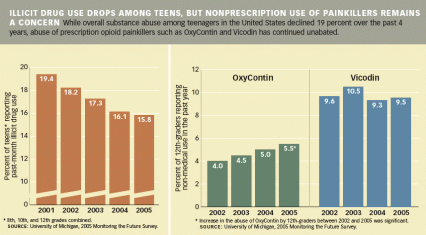Substance abuse among teenagers in the United States declined 19 percent over the past 4 years, with 15.8 percent reporting past-month abuse in 2005, compared with 19.4 percent in 2001, according to the latest Monitoring the Future Survey. The nationwide survey of 8th-, 10th-, and 12th-graders found that the overall decline was tempered by increases or unchanged rates of abuse of some prescription drugs, inhalants, and other substances.
The 4-year decline has been driven largely by decreasing rates of marijuana abuse. For example, since 2001, past-month abuse of marijuana fell by 28 percent among 8th-graders and by 23 percent among 10th-graders. Although most year-to-year changes in the annual survey are not statistically significant, teen abuse of five substances—GHB, LSD, MDMA/Ecstasy, methamphetamine, and steroids—showed significant declines from 2004 to 2005.
The survey findings are encouraging because teenagers are most vulnerable to the effects of drugs and youths who abstain in their teen years are less likely to abuse drugs later in life, NIDA Director Nora D. Volkow, M.D., says. She notes, however, that teens' abuse of prescription medications and inhalants has continued unabated in the past few years. NIDA is particularly concerned about the nonprescribed use of opioid painkillers, such as OxyContin and Vicodin. In 2005, 9.5 percent of 12th-graders reported abusing Vicodin in the past year, and 5.5 percent reported OxyContin abuse, which has increased more than one-third since 2002. "Using these drugs without a prescription is dangerous. It's imperative that teens get this message," Dr. Volkow stresses.
Abuse of inhalants, which are found in common household substances such as nail polish remover, glue, and cleaning fluids and are very toxic, also has been rising in recent years. Abuse among eighth-grade students has increased significantly since 2002, Dr. Volkow says.
Smoking Decline May Be Tapering Off
Dr. Lloyd Johnston of the University of Michigan, the principal investigator of the study, notes a worrisome signal that the decline in smoking may be tapering off: The smoking rate among eighth-graders held steady in the latest survey, following a long-term decline over the past several years. Eighth-graders are considered an important bellwether of drug-related trends among teenagers. Moreover, smoking declines in the upper grades also slowed in 2005. Survey data do not indicate long-term declines in the abuse of marijuana and other illicit drugs among 8th-graders, and declines among 10th- and 12th-grade students were very modest, Dr. Johnston notes.
On the positive side, cigarette smoking is at its lowest rate in the 30-year history of the survey. Also, the proportion of eighth-graders reporting that they have ever tried to smoke cigarettes declined in the latest survey, which could reflect shifts in behaviors and intentions that occurred several years earlier.
The survey covered about 50,000 students in more than 400 public and private schools. The University of Michigan conducted the survey under a grant from NIDA, the National Institutes of Health, and the Department of Health and Human Services. Further details on the survey are available at Monitoring the Future Trends and Statistics and at monitoringthefuture.org.
